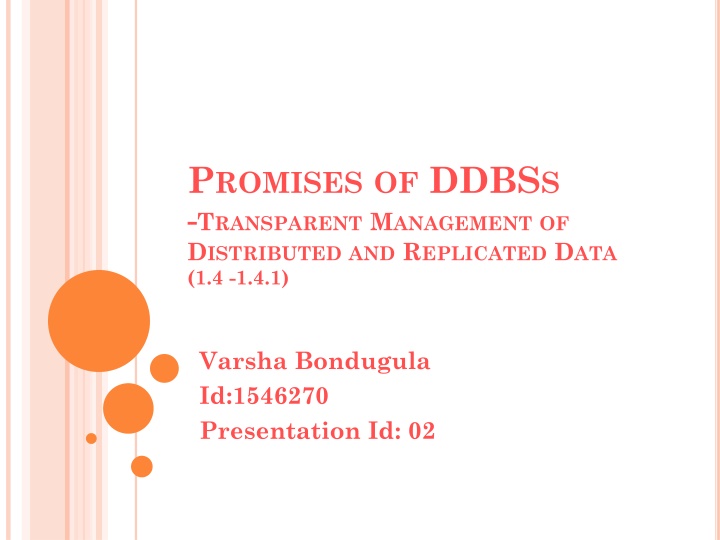
Transparent Management of Distributed and Replicated Data in DDBS
Learn about the promises of Distributed Database Management Systems (DDBS) in providing transparent management of distributed and replicated data. Explore the different types of transparencies, the fundamentals of DDBS technology, and examples illustrating the benefits of transparent systems. Understand how data independence, network transparency, replication transparency, and fragmentation transparency play critical roles in distributed database management.
Download Presentation

Please find below an Image/Link to download the presentation.
The content on the website is provided AS IS for your information and personal use only. It may not be sold, licensed, or shared on other websites without obtaining consent from the author. If you encounter any issues during the download, it is possible that the publisher has removed the file from their server.
You are allowed to download the files provided on this website for personal or commercial use, subject to the condition that they are used lawfully. All files are the property of their respective owners.
The content on the website is provided AS IS for your information and personal use only. It may not be sold, licensed, or shared on other websites without obtaining consent from the author.
E N D
Presentation Transcript
PROMISES OF DDBSS -TRANSPARENT MANAGEMENT OF DISTRIBUTED AND REPLICATED DATA (1.4 -1.4.1) Varsha Bondugula Id:1546270 Presentation Id: 02
OUTLINE: Promises of DDBSs Transparent Management of Distributed and Replicated Data Different types of transparencies Data Independence Network Transparency Replication Transparency Fragmentation Transparency Who Should Provide Transparency?
PROMISES OF DDBSS A distributed database management system (distributed DBMS) is then defined as the software system that permits the management of the distributed database and makes the distribution transparent to the users. The two important terms in this system are logically interrelated and distributed over a computer network. What we are interested in is an environment where data are distributed among a number of sites.
There are four fundamentals which may also be viewed as promises of DDBS technology: Transparent management of distributed and replicated data. Reliable access to data through distributed transactions, Improved performance Easier system expansion.
TRANSPARENT MANAGEMENTOF DISTRIBUTEDAND REPLICATED DATA A transparent system is a system which hides the implementation details from users. Let us start our discussion with an example. Consider an engineering firm that has offices in Boston, Waterloo, Paris and San Francisco. They run projects at each of these sites and would like to maintain a database of their employees, the projects and other related data. Assuming that the database is relational, we can store this information in two relations: EMP(ENO, ENAME, TITLE) and PROJ(PNO, PNAME, BUDGET).
We also introduce a third relation to store salary information: SAL(TITLE, AMT) and a fourth relation ASG which indicates which employees have been assigned to which projects for what duration with what responsibility: ASG(ENO, PNO, RESP, DUR). If all of this data were stored in a centralized DBMS, and we wanted to find out the names and employees who worked on a project for more than 12 months, we would specify this using the following SQL query: SELECT ENAME, AMT FROM EMP, ASG, SAL WHERE ASG.DUR > 12 AND EMP.ENO = ASG.ENO AND SAL.TITLE = EMP.TITLE
Furthermore, it may be preferable to duplicate some of this data at other sites for performance and reliability reasons. The result is a distributed database which is fragmented and replicated
Fully transparent access means that the users can still pose the query as specified above, without paying any attention to the fragmentation, location, or replication of data, and let the system worry about resolving these issues. For a system to adequately deal with this type of query over a distributed, fragmented and replicated database, it needs to be able to deal with a number of different types of transparencies. Data Independence Network Transparency Replication Transparency Fragmentation Transparency
Data Independence Data independence is a fundamental form of transparency that we look for within a DBMS. There are two types of data independence: logical data independence and physical data independence. Logical data independence refers to the immunity of user applications to changes in the logical structure (i.e., schema) of the database and Physical data independence, deals with hiding the details of the storage structure from user applications. When a user application is written, it should not be concerned with the details of physical data organization. Therefore, the user application should not need to be modified when data organization changes occur due to performance considerations.
Network Transparency User should be protected from the operational details of the network; possibly even hiding the existence of the network. This type of transparency is referred to as network transparency or distribution transparency. Replication Transparency For performance, reliability, and availability reasons, it is usually desirable to be able to distribute data in a replicated fashion across the machines on a network. Furthermore, if one of the machines fails, a copy of the data are still available on another machine on the network. In fact, the decision as to whether to replicate or not, and how many copies of any database object to have, depends to a considerable degree on user applications.
Fragmentation Transparency There are two general types of fragmentation alternatives. Horizontal fragmentation, a relation is partitioned into a set of sub- relations, each of which have a subset of the tuples (rows) of the original relation and vertical fragmentation where each sub-relation is defined on a subset of the attributes (columns) of the original relation. Who Should Provide Transparency? To provide easy and efficient access by users to the services of the DBMS, one would want to have full transparency. Responsibility of providing transparent access depends on the access layer, operating system level & within the DBMS.
